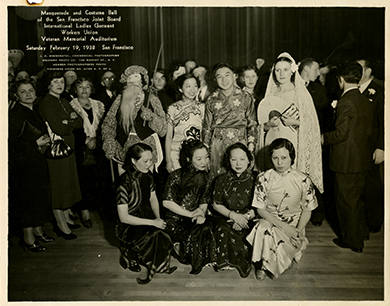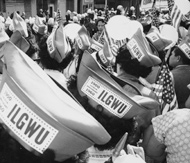

Highlights
The ILGWU Across the USA

The ILGWU in San Francisco
A local of cloakmakers in San Francisco was around in the first decade of the ILGWU, but was disbanded in 1913. In May 1915, members of the former local joined with an independent union of ladies’ tailors to revive Local 8. The thirteen week strike of San Francisco cloakmakers in 1923 basically decimated Local 8. Brother L. Gold of Los Angeles was placed in charge of the San Francisco market and new members were organized during the next few years, but by 1928, Local 8 Cloakmakers were practically out of existence again as Communists had “captured” the organization. In 1929, those that had remained loyal to the ILGWU kept the struggling Local 8 alive. The San Francisco cloak trade at that time was small, with a few hundred cloakmakers. Local 8 was soon joined in the 1930s by new charters Dressmakers Local 101, Knitgood Workers Local 191, and Cutters Local 213. With the creation of Local 101 in 1933, Jennie Matyas came to San Francisco to help organize the dressmakers and would later serve as the education director of the San Francisco Joint Board. In the 1940s, San Francisco had a sizable dress market with two locals, 101 and 352 (General Garment Workers’ Union). During this time, Henry Zacharin served as manager of the Joint Board. While smaller in scale than Los Angeles, the San Francisco garment industry was 100 percent unionized, and by 1947, the Joint Board was composed of Locals 8, 101, 213, and 352.
Garment workers in San Francisco received a 35 hour work week with the new sportswear agreement in 1953. By the mid-1950s (1956), the Joint Board was now managed by Ralph King, and the locals were signing contracts with Chinatown contractors. King served as manager until the 1960s (1962), when Cornelius Wall took over leadership of the San Francisco Joint Board. In 1967, the ILGWU and the labor movement in San Francisco joined efforts to unionize Chinatown. The 1970s (1971), saw the name of Pacific Coast Region change to Western States Region, and Mattie Jackson became manager of the Joint Board. Jackson was previously a business agent at the Koret of California shop. Complicated conditions continued to thwart organizing efforts in Chinatown, though by the mid-1970s, in roads were being made in the shops. By 1977, Asian immigrants constituted the bulk of the non-union workforce in San Francisco. In 1980, the San Francisco Joint Board was merged into the Pacific Northwest District Council that was managed by Mattie Jackson.
Kathryn Dowgiewicz


